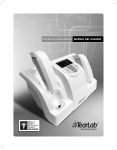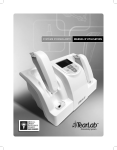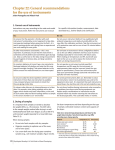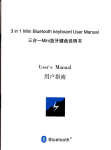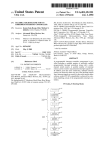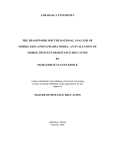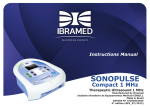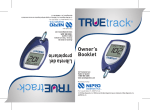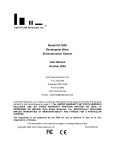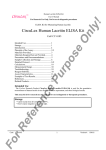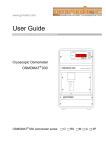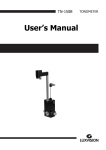Download CLIA WAIVED OSMOLARITY SYSTEM - USER MANUAL
Transcript
OSMOLARITY SYSTEM - USER MANUAL
CLIA WAIVED
OSMOLARITY SYSTEM
CONTENTS
C L IA CON SIDER ATION S
The TearLab Osmolarity System is a CLIA-waived test system for human tears. Each laboratory or testing site using the TearLab Osmolarity System
must have a CLIA Certificate of Waiver before starting testing. To obtain a Certificate of Waiver, call your state department of health or TearLab
Customer Support at 1-858-455-6006 for an application (Form CMS-116). TearLab can provide the phone number of your state department of health
and assist you in filling out the application. The TearLab Osmolarity System is a waived test so long as it is used according to the instructions in the
Package Insert. Any modification by the laboratory to the test system or the test system instructions will result in this test no longer meeting the
requirements for waived categorization. A modified test is considered to be high complexity and is subject to all applicable CLIA requirements.
Inclu ded Contents:
TearLab Reader
PEN
TearLab Reader
(2) TearLab individually boxed
Pens with magnetic cardboard
sleeves, Instructions for Use, and a
set of adhesive identification labels
Sold Separately:
Electronic
Check Cards
Set of (2) Electronic Check Cards
with Instructions for Use
TearLab User Manual
TearLab Quick Reference Guides
Power Supply
Power Cord(s)
OSMOLARITY SYSTEM
Osmolarity
Control Solutions
TA B L E O F CO N T E N T S
Product Overview. . . . . . . . . . . . . . . . . . . . . . . . . . . . . . . . . . . 1
Principles of the Procedure. . . . . . . . . . . . . . . . . . . . . . . . . . . 1
System Components. . . . . . . . . . . . . . . . . . . . . . . . . . . . . . . . .
Osmolarity System Reader. . . . . . . . . . . . . . . . . . . . . . . . . . . .
Osmolarity System Pen. . . . . . . . . . . . . . . . . . . . . . . . . . . . . . .
Osmolarity Test Card. . . . . . . . . . . . . . . . . . . . . . . . . . . . . . . . .
Electronic Check Card. . . . . . . . . . . . . . . . . . . . . . . . . . . . . . . .
Osmolarity
Test Cards
1
1
1
1
2
Installation . . . . . . . . . . . . . . . . . . . . . . . . . . . . . . . . . . . . . . . . . 2
Initial Setup and Menu Navigation . . . . . . . . . . . . . . . . . . . . 3
Recall Keys and Test Memory. . . . . . . . . . . . . . . . . . . . . . . . . 3
Pens. . . . . . . . . . . . . . . . . . . . . . . . . . . . . . . . . . . . . . . . . . . . . . . . . .
TearLab Pens . . . . . . . . . . . . . . . . . . . . . . . . . . . . . . . . . . . . . . . .
Low Battery Warning. . . . . . . . . . . . . . . . . . . . . . . . . . . . . . . . .
Long-Term Pen Storage . . . . . . . . . . . . . . . . . . . . . . . . . . . . . .
Wake and Sleep Modes. . . . . . . . . . . . . . . . . . . . . . . . . . . . . . .
3
3
3
3
4
Quality Control. . . . . . . . . . . . . . . . . . . . . . . . . . . . . . . . . . . . .
Calibration. . . . . . . . . . . . . . . . . . . . . . . . . . . . . . . . . . . . . . . . . . . . . . . . . .
Electronic Check Card . . . . . . . . . . . . . . . . . . . . . . . . . . . . . . . . . . . . . .
Testing the Electronic Check Card. . . . . . . . . . . . . . . . . . . . . . . . . .
Control Solutions. . . . . . . . . . . . . . . . . . . . . . . . . . . . . . . . . . . . . . . . . . .
Contraindications. . . . . . . . . . . . . . . . . . . . . . . . . . . . . . . . . . . . . . . . . . .
4
4
4
4
5
5
Osmolarity Test. . . . . . . . . . . . . . . . . . . . . . . . . . . . . . . . . . . .
How to Perform an Osmolarity Test. . . . . . . . . . . . . . . . . . . . . . . . .
Before Each Test. . . . . . . . . . . . . . . . . . . . . . . . . . . . . . . . . . . . . . . . . . . .
Tear Collection Procedure . . . . . . . . . . . . . . . . . . . . . . . . . . . .
Get the Results . . . . . . . . . . . . . . . . . . . . . . . . . . . . . . . . . . . . . .
5
5
5
6
6
Testing Osmolarity Controls . . . . . . . . . . . . . . . . . . . . . . . . . . 7
Performance. . . . . . . . . . . . . . . . . . . . . . . . . . . . . . . . . . . . . . . .
Result Interpretation. . . . . . . . . . . . . . . . . . . . . . . . . . . . . . . . . . . . . . . .
Expected Results . . . . . . . . . . . . . . . . . . . . . . . . . . . . . . . . . . . . . . . . . . .
Accuracy (Method Comparison) .. . . . . . . . . . . . . . . . . . . . . . . . . . . .
7
7
7
8
CLINICAL STUDIES . . . . . . . . . . . . . . . . . . . . . . . . . . . . . . . . . . . . . 9
Calibration Data . . . . . . . . . . . . . . . . . . . . . . . . . . . . . . . . . . . . . . . . . . . . . 9
Performance on Patients with Objective Signs of Dry Eye. . . . . 9
Specifications. . . . . . . . . . . . . . . . . . . . . . . . . . . . . . . . . . . . . . .
Power Requirements . . . . . . . . . . . . . . . . . . . . . . . . . . . . . . . . . . . . . .
Power Supply. . . . . . . . . . . . . . . . . . . . . . . . . . . . . . . . . . . . . . . . . . . . . .
System Classification. . . . . . . . . . . . . . . . . . . . . . . . . . . . . . . . . . . . . . .
Pen Power Source . . . . . . . . . . . . . . . . . . . . . . . . . . . . . . . . . . . . . . . . .
Environmental Conditions. . . . . . . . . . . . . . . . . . . . . . . . . . . . . . . . .
10
10
10
10
10
10
Hazards. . . . . . . . . . . . . . . . . . . . . . . . . . . . . . . . . . . . . . . . . . . . . 10
Precautions. . . . . . . . . . . . . . . . . . . . . . . . . . . . . . . . . . . . . . . . 11
Operational Precautions. . . . . . . . . . . . . . . . . . . . . . . . . . . . . . . . . . . 11
Maintenance. . . . . . . . . . . . . . . . . . . . . . . . . . . . . . . . . . . . . . . . 11
Technical Service . . . . . . . . . . . . . . . . . . . . . . . . . . . . . . . . . . . . . . . . . . 11
Replacement Parts. . . . . . . . . . . . . . . . . . . . . . . . . . . . . . . . . . . . . . . . . 11
Troubleshooting. . . . . . . . . . . . . . . . . . . . . . . . . . . . . . . . . . . 12
Warranty . . . . . . . . . . . . . . . . . . . . . . . . . . . . . . . . . . . . . . . . . . . 14
EMC AND SAFETY. . . . . . . . . . . . . . . . . . . . . . . . . . . . . . . . . . . . . 14
REFERENCES . . . . . . . . . . . . . . . . . . . . . . . . . . . . . . . . . . . . . . . . . . 16
OSMOLARITY SYSTEM
PRODUCT OVERVIEW
The TearLab Osmolarity System is intended to measure the osmolarity of human tears to aid in the diagnosis of Dry Eye Disease in patients
suspected of having Dry Eye Disease, in conjunction with other methods of clinical evaluation.
Tears fulfill an essential role in maintaining ocular surface integrity, protecting against microbial challenge, and preserving visual acuity. These
functions, in turn, are critically dependent upon the composition and stability of the tear film structure.1
Osmolarity is a basic and essential aspect of physiologic homeostasis in body fluids. Small deviations in homeostasis, such as variations in pH,
temperature, glucose and oxygen concentrations, and osmotic pressure, activate physiological mechanisms to return that variable to its set point.
The body is able to regulate osmolarity of body fluids within very narrow limits through various mechanisms of osmoregulation, such as the
compensation and correction of fluid volume and salt concentration. Hyperosmolarity of any body fluid, including tear fluid, indicates a disorder
in the body’s ability to regulate homeostasis and is a basic indication of a physiological disorder. The higher the osmolarity, the more concentrated
the tear films.2
Hyperosmolarity has been described in the literature as a primary marker of tear film integrity.3 When either the quantity or the quality of secreted
tears is compromised (known as aqueous deficient or evaporative Dry Eye Disease), an increased evaporation rate leads to a concentrated tear film
(increased osmolarity) that places stress on the corneal epithelium and conjunctiva.
The TearLab Osmolarity Test Card, in conjunction with the TearLab Osmolarity System, provides a quick and simple method for determining tear
osmolarity using nanoliter (nL) volumes of tear fluid collected directly from the eyelid margin. To perform a test, attach a new Test Card onto the
Pen and touch the tip of the Pen to the tear fluid meniscus, located above the lower eyelid. After a successful collection, dock the Pen into the
Reader, which will display a quantitative tear osmolarity test result on the liquid crystal display (LCD). The TearLab Osmolarity System simplifies the
tear-collection process by eliminating the need to transfer tear fluid samples and reducing the risk of evaporation.
P R IN C IP LES OF TH E PROCEDUR E
The TearLab Osmolarity Test utilizes a temperature-corrected impedance measurement to provide an indirect assessment of osmolarity.4 After
application of a calibration curve to the steady-state electrical impedance of the tear fluid, osmolarity is calculated and displayed as a quantitative
numerical value.
OSMOLARITY SYSTEM
SYSTEM COMPONENTS
T ear L a b Osmolarit y System R eader
The Reader is a portable countertop unit that calculates and displays the osmolarity test result. The Reader has an LCD screen, a keypad, and an
external AC power supply. Left and right cradles allow two Pens to dock into the Reader. When Pens are docked, the Reader automatically converts
the tear fluid sample data into an osmolarity measurement and displays the reading on the LCD.
T ear L a b Osmolarit y System Pen
The Pen is designed to hold the Test Card and facilitate safe, simple tear fluid collection. The Pen electronics confirm the proper attachment of
the Test Card onto the Pen, detect the presence of tear fluid in the Test Card, and signal when a tear fluid sample has been successfully collected.
Powered by a permanent rechargeable battery, the Pen provides a mechanical/electrical interface to convey data to the Reader automatically
when docked. Each TearLab Osmolarity System includes two Pens to allow sequential tear fluid sample collection from multiple patients or from
the left and right eyes of a single patient.
T ear L a b Osmolarit y Test C ard
Each Test Card is a single-use, individually packaged, nonsterile, polycarbonate microchip containing (a) microfluidic channel to collect 50
nanoliters (nL) of tear fluid by passive capillary action, and (b) gold electrodes embedded in the polycarbonate microfluidic channel to enable
on-board measurement of tear osmolarity. Test Cards are clinically hygienic and have a protective cover that should be removed only after the
Test Card has been successfully attached onto the Pen and immediately prior to tear collection. Each Test Card is imprinted with a code that
must be entered into the Reader at the time of testing. Designed to work in conjunction with the TearLab Pen, the Test Card does not contain
chemicals or reagents, and collects tear fluid in less than one second. Please note that TearLab Osmolarity Test Cards are not included with the
TearLab Osmolarity System and must be purchased separately.
1
T ear L a b Electronic Check C ards
Two identical, blue, reusable Electronic Check Cards are provided as a procedural quality control to confirm the function and calibration of the
TearLab Osmolarity System within manufacturer specifications. The Electronic Check Cards can be used simultaneously for quality control testing,
one with each Pen. The Electronic Check Cards can be used to verify the function of the TearLab if it is mishandled or the Pens are dropped. Tear
fluid samples cannot be collected with the Electronic Check Cards.
OSMOLARITY SYSTEM
I N S TA L L AT I O N
A Reader, two Pens, a power supply, power cord(s), and Electronic Check Cards are delivered together with Osmolarity System User Manual(s) and
Quick Reference Guide(s). Open the carton on a stable surface, remove the components, and set them on a flat surface with at least two inches of
space around the Reader. The Reader and Pens should not be used in direct sunlight and should be at ambient temperature (15°–30°C/59°–86°F)
before use. After the Reader is switched ON, a 25-minute warm-up before use is required. The Reader will indicate when it is ready for use.
1. Each Pen comes with a set of identification labels that can be affixed to the back of the Pen to
distinguish one Pen from the other. Affix labels to the back of each Pen, if desired. Each Pen is also supplied
with a reusable magnetic cardboard sleeve for long-term storage. DO NOT DISCARD. (See “Long-Term Pen
Storage” section on page 3 of this manual.)
2. Insert each Pen into a cradle. The Reader has two cradles to allow simultaneous docking of both Pens.
Either Pen will function in either cradle.
3. Select the power cord that corresponds to your local electrical outlet configuration. Connect the power
cord to the power supply, plug the power cord into an electrical outlet, and connect the power supply to the
back of the Reader. Locate the switch on the back of the Reader and set to the ON
position.
Warnin g : Modification of this equipment is not recommended. This may cause a safety hazard and will
nullify the manufacturer’s warranty. Do not locate the TearLab System directly in front of the power outlet. The
power cord and plug must be accessible for removal from the power outlet.
Initial Setup and Menu Navigation
once to enter the Menu Mode and setup screen.
Upon first use, press the MENU Key
Press the RECALL Key
below the up and down arrows to scroll.
to choose a menu item.
Press the OK Key
to return to the main screen.
Press the MENU Key
to display the previous test result.
When in Test Mode, press the RECALL Key
2
REC AL L KEYS AND TEST MEMO RY
There are two RECALL Keys
previous test result.
corresponding to the left and right cradles. RECALL Keys are used to view the
To recall the previous test result, press and hold the RECALL Key. The previous test result will be displayed on a
dark background to distinguish it from the current test result. Release the RECALL Key and the LCD will revert to
the active screen, displaying the current test result or operation screen. Only the last test result will be held in
memory, and it will remain in memory until the Reader is turned OFF. The RECALL Keys also function as UP and
DOWN arrows when you are entering the code or navigating the menu.
When turned ON, the Reader LCD will display “Ready,” indicating that testing may be performed. The LCD is split
into left and right sides, corresponding to the left and right docking cradles.
OSMOLARITY SYSTEM
PENS
TEARL AB Pens
Each Pen contains a permanent rechargeable battery. Pens should be docked in the Reader and allowed to
charge for 20 minutes before initial use. The Pen battery automatically recharges when the Pen is docked in
the Reader and the power is switched ON. It is recommended that the Reader power remain ON for continuous Pen battery charging. Battery icons are located in the left and right corners of the LCD. A flashing battery icon
indicates that the battery is charging. If the icon is not flashing, the battery is fully charged. Pen batteries will not
overcharge.
WA R N I N G : Only collect tears if the green light is on. NEVER collect tears when the green light is off.
If a Test Card is attached and there is no beep and no green light from the Pen, DO NOT collect tears.
LOW BAT TE RY WAR NING
When a Pen with low battery power is removed from the Reader, the Reader will emit two informational beeps
and the “BAT LOW” message will appear on the LCD. Do not perform testing. Dock the Pen into the Reader to
charge the battery. When “BAT LOW” changes to “Ready,” the Pen is ready to perform a test.
LON G-TERM PEN STO R AGE Please retain Pen box and magnetic cardboard
sleeve for long-term storage.
The Pen is packaged with a magnetic cardboard sleeve that automatically turns the Pen OFF when the Pen
is properly inserted. When the magnetic cardboard sleeve is removed, the Pen automatically turns ON. The
Pen will remain ON indefinitely, in either Wake Mode or Sleep Mode. If the Pen is not used for 30 days or more, it
is recommended to store the Pen in the magnetic cardboard sleeve and in its original box to turn the Pen OFF
and to conserve the life of the battery. Failure to store the Pen properly may result in a battery that is discharged
beyond its ability to recharge.
Pen batteries are permanent and cannot be exchanged or replaced. Battery failure requires replacement of the Pen.
The Pen battery will not overcharge.
If the Pen has been dropped or mishandled, test with an Electronic Check Card to verify that it is functioning properly before testing patients
or Control Solutions.
3
WAKE and SLEEP MO DES
The Pen will enter Sleep Mode when not in use and will automatically awaken when a new Test Card is attached,
as indicated by the green light and the beep. The Pen will remain in Wake Mode for two minutes. If two minutes
pass without tear collection, the Pen will return to Sleep Mode and the green light will turn off. To wake the Pen,
remove the Test Card and reattach it onto the Pen. The green light will illuminate and the Pen will beep.
Following tear collection, a user has 40 seconds to return the Pen to the Reader before the Pen enters Sleep
Mode. If the Pen enters Sleep Mode following tear collection, the data will be erased and the Test Card will not
be able to be reused.
WA R N I N G : P en should always be docked immediately after tear collection to avoid loss of data.
OSMOLARITY SYSTEM
QUALITY CONTROL
C A L IB R AT ION
The manufacturer calibrates the TearLab Osmolarity System against a reference standard solution prepared from dried, high-purity sodium chloride
traceable to the National Institute of Standards and Technology (NIST). Calibration by the user is not required.
Electronic Check C ard
The blue Electronic Check Card should be tested on each Pen before each day of patient testing, or if the Pen
has been dropped or mishandled, to verify that the system is performing within manufactured calibration
specifications. Values obtained with the Electronic Check Card should not deviate by more than +/- 3.0 mOsms/L
(units of osmolarity) from the expected value.
The TearLab Osmolarity System comes with two identical blue reusable Electronic Check Cards. The Electronic
Check Cards can be used simultaneously, one on each Pen, for quality control testing.
WA R N I N G : Fluid samples cannot be collected with the Electronic Check Card. DO NOT try to collect tears or
Control Solutions with the blue Electronic Check Card.
Testing the Electronic C heck C ard
1. Attach an Electronic Check Card onto a Pen. The green light on top of the Pen will illuminate and the Pen will
beep. Wait approximately five seconds for the Pen to beep again or for the green light to turn off.
2. After the green light turns off, dock the Pen into the Reader. The LCD will display a code number. It is not
necessary to enter a specific code for Electronic Check Cards. Press OK to accept any code.
3. The LCD will display a test result that should fall within the expected value range indicated in the
Instructions for Use provided with the Electronic Check Cards.
Remove the Pen and press the RECALL Key to confirm that the test result was properly stored in memory.
Repeat the procedure with the other Pen.
Record the date and the Electronic Check Card test results in a quality log.
4
Control Solutions
Good laboratory practice suggests the use of Normal and High Osmolarity Control Solutions to ensure that the
TearLab Osmolarity System is functioning properly. Test both levels of control solution with each new shipment
of test cards (even if the lot number is the same), with each new lot number, and monthly to check storage. To
ensure proper performance with the TearLab Osmolarity System, only TearLab Osmolarity Control Solutions should
be used. Osmolarity Control Solutions are not included with the TearLab Osmolarity System or the TearLab
Osmolarity Test Cards. If correct electronic or control solution test results are not obtained, do not test patient
samples; instead, contact your local sales representative or TearLab Customer Support in your area.
Please refer to the “Testing Osmolarity Controls” section on page 7 of this manual for the Osmolarity “Control Solutions” testing procedure.
CON T R AIN DIC ATION S
Human tear fluid samples may be used. Collect tear fluid samples directly from the eye.
Do not collect tear fluid from a patient within two hours of medicinal eye drop use or use of topical medications.
Do not collect or store tear fluid samples for transport or testing at a later time.
Do not collect tear fluid after ocular surface staining.
Do not collect tear fluid within 15 minutes of use of anesthetic or mydriatic (dilating) eye drops or after other invasive ocular
diagnostic testing.
Do not collect tear fluid within 15 minutes after a slit lamp examination.
Do not collect tear fluid within 15 minutes from a patient who has been crying.
WA R N I N G : If either the Electronic Check Card or the Control Solution test results do not match the expected value range, do not test patients.
Contact your local sales representative or TearLab Customer Support for assistance.
OSMOLARITY SYSTEM
OSMOLARITY TEST
How to Perfor m an Osmolarit y Test
N OT E : Use appropriate clinically hygienic methods when collecting tears.
Before each test:
Remove either Pen from the Reader. The LCD will display “Ready.”
N OT E : Do not collect tear samples if the Reader does not display “Ready.”
Cover
Wing
Remove a Test Card from its package and attach it onto the Pen. The Pen will beep and the green light will
illuminate when the Card is attached properly. The green light will remain on until tears are collected or the
Pen times out (after two minutes).
Remove the protective cover by holding the wings of the Test Card firmly and pulling the sheath up and off
of the Test Card.
WA R N I N G : A Test Card without a protective cover should be considered used. DO NOT use for patient testing.
5
Tear Collection Proced ure
N O T E : For Osmolarity Controls, refer to the “Testing Osmolarity Controls” section on page 7.
Seat the patient with chin tilted upward and eyes directed toward the ceiling.
Place one hand on the face for stabilization. Do not pull the eyelid down or away from the eye.
Position the tip of the Pen just above the lower eyelid.
Gently lower the Pen until the bottom of the tip touches the thin line of moisture between the eyelid and the
eye. It is not necessary to press inward toward the eye.
The Pen will beep and the green light will turn off after a successful tear collection.
N O T E : Sometimes when there is very little tear, the act of withdrawing the Pen breaks the surface tension of the
tear meniscus and allows tears to enter the microfluidic channel. In this case, the Pen will beep upon withdrawal,
indicating a successful tear collection.
N O T E : Tear collection should be performed at the lateral (temporal) extent of the eyelid where the risk of
inadvertent injury to the cornea can be minimized, rather than adjacent to the cornea where injury is more likely.
To g et the result
Locate the code on top of the Test Card (see example in picture).
Dock the Pen into the Reader within 40 seconds of collecting the sample.
Immediately press the RECALL Key
below the up and down arrows to select the Test Card code.
I M P O R TA N T: If a code is not selected within eight seconds, the Reader will automatically use the default
code displayed on the LCD. It is important to select the correct code to obtain an accurate osmolarity test result.
Press the OK Key
or wait eight seconds to accept the code.
The test result will display in a few seconds.
Record the date and test result in the patient chart.
N O T E : After recording test result, remove the used Test Card from the Pen by pressing forward on top of the
Test Card with your thumb. Do not pull from the wings. Dispose in an appropriate manner (reference page 10
HAZARDS).
6
Testin g Osm olarit y Controls
Test both levels of control solution with each new shipment of test cards even if the lot number is the same), with
each new lot number, and monthly to check storage. Read the control solution instruction sheet for expected
values.
Attach a test card to the pen (refer to the “How to Perform an Osmolarity Test” section
on page 5 of this manual).
Do NOT collect tears.
Instead of collecting tears, use a control solution.
Use the blue sleeve to snap off the top of an ampule.
Turn the ampule upside down (the fluid will not spill out).
Touch the tip of the pen to the control solution.
Return the Pen to the reader, enter the code.
Check control result to the expected value.
If within the expected range patient testing may proceed.
If not within the expected range you should not perform patient testing. Contact
TearLab customer support in your area or call TearLab at (858) 455-6006.
OSMOLARITY SYSTEM
P erformance
R esu lt I nter pretation
TearLab test results are displayed on the LCD in mOsms/L. No calculations are required. Osmotic concentration determinations are often expressed
as either osmolarity (milliosmoles/liter i.e., mOsms/L or as centiosmoles/liter i.e., cOsms/L) or osmolality (milliosmoles/kilogram,i.e., mOsms/kg
or as centiosmoles/kg, i.e., cOsms/kg). In tear fluid the difference between osmolarity and osmolality is insignificant, and it is common in the
clinical literature to use the terms interchangeably.5
TearLab measurement range is linear from 275–400 mOsms/L. Test results outside this range will be reported as either “Below Range,” indicating a
measurement below 275 mOsms/L, or “Above Range,” indicating a measurement above 400 mOsms/L. Osmolarities outside the stated range
are very rare and should generally be confirmed with a subsequent test, as values outside the measurement range may be indicative of an error
(e.g., user error during the test).
E x p ected Resu lts
Reference tear osmolarity values for Normal and Dry Eye osmolarity levels.
N O T E : Osmolarity may differ from left eye to right eye, and each eye should be tested and assessed to determine which eye represents
higher osmolarity.
Normal: Mean 309.9 mOsms/L ± 11.0 (288–331 mOsms/L; 90% CI 288–331)
Dry Eye Disease: Mean 324.3 mOsms/L ± 20.1 (291–382 mOsms/L; 90% CI 284–392)
The results of the TearLab Osmometer should be evaluated with all clinical and laboratory data available. If the results do not agree with the clinical
evaluation, additional tests should be performed. Osmolarities above or below the measurement range are very rare and should generally be
confirmed with subsequent testing, as values outside the measurement range may indicate an error (e.g., user error during the test). Test only on
human tears or TearLab Osmolarity Control Solutions.
7
Acc u rac y ( Method Comparison)
The correlation study was performed internally by the manufacturer using contrived tear samples of various osmolarity levels within the
clinical reference range on both the TearLab Osmolarity System and the Wescor Model 5520 vapor pressure osmometer calibrated to
NIST- traceable standards.
No. Sites
N
Regression Line
r2
1
80
y = 0.9146x + 23.061
0.9443
At each of three physician office sites, 40 contrived tear specimens across seven levels of the clinically significant range were prepared and
measured on the TearLab Osmolarity System. The physician office laboratories did not have access to the Wescor 5520 Vapro® vapor pressure
osmometer. Wescor values were determined by an average of two to three measurements on each level of osmolarity immediately prior to the
beginning of the study.
8
No. Sites
N
Regression Line
r2
3
120
y = 0.9402x + 12.512
0.9515
OSMOLARITY SYSTEM
C linical studies
C alibration Data
To determine clinical performance for tear film hyperosmolarity in the diagnosis of Dry Eye Disease, a meta-analysis was performed on
historical published data for tear osmolarity in samples of Normal and Dry Eye subjects. An osmolarity referent value of 316 mOsms/L was found
to yield sensitivity of 69%, specificity of 92%, and an overall predictive accuracy of 82% for the diagnosis of Dry Eye Disease. Studies in the
meta-analysis used earlier osmolarity devices, not TearLab.
Performance of Osmolarity in meta-analysis
Normal
Dry Eye
Total
≤316
750
192
942
80% NPV
>316
65
429
494
87% PPV
Total
815
621
1,436
Specificity 92%
Sensitivity 69%
[Tomlinson A, Khanal S, Ramaesh K, Diaper C, McFadyen A. Tear Film Osmolarity: Determination of a Referent for Dry Eye Diagnosis, Investigative
Ophthalmology & Visual Science, October 2006; 47(10) 4309-4315]
Perfor mance on Patients With O b jecti ve Signs of Dry Eye
140 subjects were enrolled in a multicenter study (n = 45 Normal, n = 95 Dry Eye). To qualify as a Dry Eye patient, subjects were required to have
a positive score on the Ocular Surface Disease Index (OSDI) and 2 or more positive indications of Tear Film Breakup Time (TBUT), Schirmer Test,
Corneal Staining, Conjunctival Staining, or Meibomian Gland Dysfunction. Performance of the TearLab™ Osmolarity System using these selection
criteria is shown in the table below.
TearLab Osmolarity Diagnostic Performance for Dry Eye Disease
Normal
Dry Eye
Total
≤316
32
34
66
48% NPV
>316
13
61
74
82% PPV
Total
45
95
140
Specificity 71%
Sensitivity 64%
Figures 1 & 2. Distribution of Osmolarities in Normal and Dry Eye Disease subjects
Figure 1
Figure 2
*Dry Eye distribution is not normal. It is skewed toward 400 mOsms/L.
9
OSMOLARITY SYSTEM
S P E C I F I C AT I O N S
Power Requ irements
Pen Power Source
Use only Power Supply Model PDM30US12 (XP Power)
Input: 4.5–5.5 VDC 0.6A
Internally powered by rechargeable battery
Continuous service
Power Su pply
Input voltage: 100–240 VAC
Input current: 0.6A MAX
Frequency: 47–63 Hz
Output voltage: 12 VDC
Output current: 2.5A
Class II
Continuous service
Environ m ental Conditions
Transport and storage temperature: 2°–35°C/36°–95°F
Transport and storage relative humidity: 10%–85% noncondensing
Transport and storage altitude: 0–2,000 meters
Operating temperature: 15°–30°C/59–86°F
Operating altitude: 0–2,000 meters
Operating relative humidity: 10%–85% noncondensing
S YS T EM CL ASSIFIC ATION
Class II: powered by Class II power supply
Type B applied part
Continuous service
OSMOLARITY SYSTEM
HAZARDS
The TearLab Osmolarity System is designed for stability, reliability, and safety, and it has been developed, manufactured, and marketed under
a quality management system certified to ISO 13485 (2003).
The TearLab Osmolarity System complies with the following materials:
WEEE Directive 2002/96/EC Waste Electrical and Electronic Equipment
RoHS Directive 2002/95/EC Restriction of Hazardous Substances
IEC 60601-1 Medical Electrical Equipment — General Requirements for Basic Safety and Essential Performance
The TearLab Osmolarity Test Cards do not contain reagents or chemicals.
Equipment is not suitable for use in the presence of a flammable anesthetic mixture with air or with oxygen or nitrous oxide.
The American Academy of Ophthalmology (AAO) states: “Human tears are not considered to contain significant amounts of bloodborne pathogens,
and thus do not require OSHA’s [Occupational Safety and Health Administration’s] bloodborne pathogens precautions; but exposure to human
tears does require good office hygiene practices such as hand washing. However, contact with tears contaminated with blood, such as in minor
surgery, requires the use of bloodborne pathogen precautions.”6
Proper handling and disposal methods of used Test Cards should be established according to relevant state and federal regulations.
TearLab is designed to collect samples of tear fluid from the eye, a nonsterile environment. The AAO has issued guidance to minimize the
transmission of ocular surface infectious agents. Prevention of transmission of these pathogens requires good hygienic techniques, such
as washing hands and instruments that touch the eye. Refer to the “Maintenance” section on page 11 of this manual for information
about proper cleaning of the TearLab Reader and Pen. TearLab Osmolarity Test Cards are for single use, are clinically hygienic and individually
packaged, and contain a protective cover. Never reuse or attempt to clean a Test Card. Do not touch the Test Card tip after removal of the
protective cover.
Although the device is manufactured to a level of disinfection deemed appropriate by the CDC (Division of Healthcare Quality Promotion;
“Disinfection and Sterilization of Patient-Care Equipment, 1985”; last modified June 22, 2005), it is not sterile and there is a minimal risk of infection,
ocular abrasion, or vision loss, as there is with any foreign object that is brought in direct contact with the eye, and appropriate hygiene and care
should be adhered to.
FDA MedWatch
Report a serious adverse event, product quality problem, product use error, or therapeutic inequivalence/failure that you suspect is associated
with the use of the TearLab Osmolarity System to TearLab Customer Support (Tel: 858-455-6006) and/or to FDA MedWatch ( Tel: 800-FDA-1088),
(Fax: 800-FDA-0178), or (www.fda.gov/medwatch).
10
OSMOLARITY SYSTEM
PREC AUTIONS
O P ER AT IO N AL PREC AUTION S
For professional in vitro diagnostic use only. CLIA Waived.
Use only at ambient temperature of 15°–30°C/59°–86°F.
Pen timer: In order to conserve battery life, the Pen is programmed to enter Sleep Mode automatically two minutes after it
powers up.
When a Pen is not being used for 30 days or more, store it in the magnetic cardboard sleeve to conserve battery life.
Osmolarity Test Cards are stable until the expiration date marked on the label.
Leave Test Card in its sealed pouch until use.
Do not remove the protective Test Card cover until the Test Card is attached onto a Pen. Remove the protective cover immediately prior to tear collection.
Any Test Card that does not contain a protective cover should not be used for patient testing. A Test Card that has been contaminated or
dropped without a protective cover should not be used for patient testing.
A measurement should not be performed if a Pen that contains a Test Card with a patient sample has been dropped. Discard Test Card and
perform test with an Electronic Check Card to verify that the Pen is performing correctly.
Avoid touching the tip of the Test Card.
Test Cards are for single use only. Never reuse or try to clean a Test Card.
Dock the Pen into the Reader within 40 seconds of collecting a sample or the Pen will time out (T/O). The Pen will emit a series of reminder
beeps approximately 30 seconds after tear collection to prompt immediate docking. A Pen docked into the Reader after 40 seconds will
display a “Pen T/O” error message; all data will be lost, and the test will be invalid.
Test Card should not be removed after tear collection or prior to docking, or data will be lost.
Tear collection should not be attempted if the green light on the Pen is not illuminated. The green light will not illuminate if battery power is
low or the Test Card is used.
Do not remove a Test Card from the Pen after tear collection until a measurement has been displayed. Removing a Test Card from the Pen prior
to docking will clear the Pen’s memory and data will be lost. The Pen will not recognize a fluid-filled Test Card if it is removed and reattached
onto the Pen.
Refer to the “Contraindications” and the “How to Perform an Osmolarity Test” sections on page 5 of this manual for tear fluid sample collection
guidelines.
Prior to use, inspect the Reader, Pen, and Test Card for physical damage. If anything is damaged, do not perform testing until the System’s
performance has been verified with both the Electronic Check Cards and the Osmolarity Control Solutions.
OSMOLARITY SYSTEM
MAINTENANCE
The TearLab Osmolarity System is designed to work without direct service or preventive maintenance. If quality checks fail, contact TearLab
Customer Support.
The TearLab Reader and Pens can be cleaned with a damp cloth or alcohol wipe as required. When cleaning, it is important to keep the electronic
contacts of the Pen and Reader dry. The electronic contacts and docking port should also be kept free of dust and dirt. Pen batteries cannot
be replaced. If the Pen battery fails to recharge, contact your sales representative or TearLab Customer Support to purchase a replacement Pen.
Cleaning fluids should never be used on the Test Cards.
T E C HN IC AL SER VICE
For technical service contact your sales representative or TearLab Customer Support. See back cover for contact information.
R EP L AC E MEN T PAR TS
To order replacement parts, contact your local sales representative or TearLab Customer Support in your area for assistance.
11
OSMOLARITY SYSTEM
12
TROUBLESHOOTING
P RO B LE M
E X PL A NATION
AC TION
Test Card is attached, green
light does not illuminate, and
Pen does not beep.
A. Test Card is not properly attached.
B. Test Card is used.
C. Pen battery is low.
D. Pen electrical contacts are worn.
1. Remove Test Card and reattach if protective cover is
still on. NEVER use a Test Card that does not have a
protective cover.
2. Dock Pen into Reader to assess battery charge level.
3. Use the Electronic Check Card to confirm Pen
function.
4. Try a new Test Card.
5. Contact TearLab Customer Support.
Pen begins beeping
approximately 30 seconds
after tear collection.
Pen will time out in 10 seconds.
Immediately dock the Pen into the Reader. Pen
must always be docked within 40 seconds of tear
collection.
Pen’s green light turns off
with an unused Test Card
attached prior to tear
collection.
A. Two minutes have passed since
attachment of Test Card, and Pen
has entered Sleep Mode.
B. Pen battery is too low for tear
collection.
1. Remove unused Test Card and reattach onto Pen.
Proceed with tear collection.
2. Dock the Pen to allow battery to recharge. Reader
LCD will indicate battery charging status.
Electronic Check Card does
not fall within the expected
value range.
The TearLab Osmolarity System does
not meet manufacturer specifications.
Retest using the second Electronic Check Card. If result
does not fall within the expected value range, contact
TearLab Customer Support.
Osmolarity Control
Solution results do not fall
within the expected value
range.
Either Test Card or TearLab Osmolarity
System does not meet manufacturer
specifications.
1. Check the expiration dates of the Test Card and
Osmolarity Control Solutions.
2. Test with the Electronic Check Card.
A. If results are out of range, contact TearLab
Customer Support.
B. If results are in range, retest Osmolarity Controls.
If results are still out of range, contact TearLab
Customer Support.
3. Do not perform patient testing until
Osmolarity Control results fall within the
expected value range.
When Pen is removed from
Reader, Pen beeps twice and
LCD displays “Bat Low.”
Pen battery is low and testing cannot
proceed.
Dock Pen into Reader to recharge battery.
Reader LCD displays “Used
T/C.”
Test Card has already been used. Test
Cards are for single use. Pen will not
accept a Test Card that has been used
previously to collect tear fluid samples.
Remove the Test Card. Attach a new Test Card and
proceed with testing. If necessary, the last test can be
recalled by pressing and holding the RECALL Key.
Reader LCD displays “Pen
T/O.”
Pen was not docked into Reader
within 40 seconds of tear collection.
Data is lost.
Retest patient with a new Test Card. Dock Pen into Reader
within 40 seconds of tear collection.
Reader LCD displays “Above
Range.”
Test result was above 400 mOsms/L.
Verify function with quality control procedures. Retest
patient, as values outside the measurement range may
be indicative of an error. Once value is confirmed, record
patient result as “Above 400 mOsms/L.”
OSMOLARITY SYSTEM
TROUBLESHOOTING
P RO B LE M
E X PL A NATION
AC TION
Reader LCD displays “Below
Range.”
Test result was below 275 mOsms/L.
Verify function with quality control procedures. Retest
patient, as values outside the measurement range may
be indicative of an error. Once value is confirmed, record
patient result as “Below 275 mOsms/L.”
Need to confirm which Test
Card code was entered onto
Reader after an osmolarity
test was performed.
Not sure if correct Test Card code
was entered onto Reader during
test. Osmolarity test result may be
inaccurate.
Using either Pen, test with an Electronic Check Card in the
same docking port as the test in question. The Test Card
code that is displayed on the Reader LCD will be the same
code as that of the last test performed. Verify that this Test
Card code matches the code for the test in question. If it
does not match, disregard the osmolarity test result.
Reader fails to detect a
docked Pen.
Pen or Reader electrical contact
failure.
Dock Pen, charge batteries, and retest with Electronic
Check Card. If error repeats or result does not fall within the
expected value range, contact TearLab Customer Support.
Reader LCD displays “E51.”
Pen/Reader communication error.
Dock Pen, charge batteries, and retest with Electronic
Check Card. If error repeats or result does not fall within the
expected value range, contact TearLab Customer Support.
Reader LCD displays “E52.”
Pen not responding to Reader.
Dock Pen, charge batteries, and retest with Electronic
Check Card. If error repeats or result does not fall within the
expected value range, contact TearLab Customer Support.
Reader LCD displays “E53.”
Communication protocol failure
between Pen and Reader.
Dock Pen, charge batteries, and retest with Electronic
Check Card. If error repeats or result does not fall within the
expected value range, contact TearLab Customer Support.
Reader LCD displays “E54.”
Reader and Pen software do not
match; size error.
Test with Electronic Check Card. If error repeats or result
does not fall within the expected value range, contact
TearLab Customer Support.
Reader LCD displays “E55.”
Reader and Pen firmware incompatible;
version error.
Test with Electronic Check Card. If error repeats or result
does not fall within the expected value range, contact
TearLab Customer Support.
Reader LCD displays “E56.”
Pen failed premeasurement relay
check.
Test with Electronic Check Card. If error repeats or result
does not fall within the expected value range, contact
TearLab Customer Support.
Reader LCD displays “E57.”
Pen battery will not hold a charge.
Test with Electronic Check Card. If error repeats or result
does not fall within the expected value range, contact
TearLab Customer Support.
Reader LCD displays “E58.”
Measurement attempted with
uncalibrated Pen.
Test with Electronic Check Card. If error repeats or result
does not fall within the expected value range, contact
TearLab Customer Support.
13
OSMOLARITY SYSTEM
WA R R A N T Y
The TearLab Reader and Pens (“Product”) are warranted against defects in material and workmanship for 12 months from the date of delivery. The
foregoing warranty is subject to the following conditions and exceptions:
Warranty excludes repair of failures resulting from mishandling or abuse. Warranty excludes consumable items such as Test Cards. Warranty does
not apply to damage sustained in transit. Warranty service may be performed only by TearLab Corporation (“TearLab”) or its authorized representative.
Warranty is void if the Product has been modified or repaired by anyone other than TearLab or its authorized representative. Warranty is
nontransferable. Warranty is void if the serial number tag is removed or altered. If the Product fails to conform to the foregoing warranty, you may
return the nonconforming Product during the 12-month warranty period accompanied by (a) a copy of the sales receipt of the Product (for the
purposes of evidencing the applicable warranty period) and (b) a Return Material Authorization (“RMA”) number for the defective Product,
obtained from TearLab prior to initiating the shipment of the defective Product to TearLab. Products returned without a sales receipt and valid
RMA number shall be returned to you, with no further obligation by TearLab regarding the Product. If you return a Product in compliance with
the foregoing requirements, TearLab shall repair or replace the Product as soon as is practicable.
THE REPLACEMENT OF THE NONCONFORMING PRODUCTS BY TearLab AS PROVIDED ABOVE SHALL BE YOUR SOLE AND EXCLUSIVE REMEDY FOR
BREACH OF THE FOREGOING WARRANTY.
OTHER THAN AS WARRANTED ABOVE, THE PRODUCT IS PROVIDED AS IS. TearLab MAKES NO OTHER WARRANTIES RELATING TO THE
PRODUCT, EXPRESS OR IMPLIED, AND EXPRESSLY DISCLAIMS ANY IMPLIED WARRANTIES, INCLUDING, WITHOUT LIMITATION, WARRANTIES OF
NONINFRINGEMENT, FITNESS FOR A PARTICULAR PURPOSE, OR MERCHANTABILITY.
In the event that you experience any difficulty with the TearLab Osmolarity System, contact your local sales representative or TearLab Customer Support.
OSMOLARITY SYSTEM
EMC AND SAFETY
Specification
Frequency Range
EN 55011: 2007, Group 1, Class ”A”
Conducted Emissions
0.15 MHz–30.00 MHz
EN 55014-1: 2006
Disturbance (Click)
0.15 MHz–30.00 MHz1
EN 55011: 2007, Group 1, Class ”A”
Radiated Emissions
30.00 MHz–1000 MHz
EN 61000-3-2: 2000/A2: 2005
Power Line Harmonics
Up to the 40th Harmonic
EN 61000-3-3: 1995/A1: 2001/A2: 2005
Power Line Flicker
Less than or equal to 4% Maximum Relative Voltage Charge; Value
of D (T) less than or equal to 3% for more than 200 ms
NOTE 1: No discontinuous disturbance (clicks) identified at this frequency range.
14
Specification
MINIMUM TEST LEVEL REQUIRED
PER EN 60601-1-2 FOR NON-LIFESUPPORT EQUIPMENT
TEST LEVEL
COMPLETED
IEC 61000-4-2: 1995/A1: 1998/A2: 2000
- Electrostatic Discharge Immunity
Air Discharge up to ± 8kV
Contact Discharge up to ± 6 kV
Air Discharge up to ± 8kV
Contact Discharge up to ± 6 kV
IEC 61000-4-3: 2006
- RF Radiated Fields Immunity
Radiation Field Strength of 3V/m
80–6000 MHz
(80% AM @ 1 kHz)
Radiation Field Strength of 3V/m
80–6000 MHz
(80% AM @ 1 kHz)
IEC 61000-4-4: 2004
+ Corrigendum 1: 2006
- Electrical Fast Transient Immunity
Power line pulses of ± 2 kV direct;
I/O line pulses of ± 1 kV
Power line pulses of ± 2 kV direct;
I/O line pulses of ± 1 kV
IEC 61000-4-5: 2005
- Lightning Surge Immunity
Power line surge of ± 2 kV common,
± 1 kV differential mode
Power line surge of ± 2 kV common,
± 1 kV differential mode
IEC 61000-4-6: 2004/A2: 2006
- RF Common Mode Immunity
150 kHz–80 MHz at 3 Vrms 1 kHz
80% amplitude modulated
150 kHz–80 MHz at 3 Vrms 1 kHz
80% amplitude modulated
IEC 61000-4-8: 1993/A1: 2000
Power Frequency Magnetic Field
Immunity
Helmholtz coil at 50 Hz and 60 Hz,
to 3 Amps (rms) per meter
Helmholtz coil at 50 Hz and 60 Hz,
to 3 Amps (rms) per meter
IEC 61000-4-11: 2004
- Voltage Dips and Short Interruptions
Voltage dips of >95%, 30%, and
60%; interruptions of >95%
Voltage dips of >95%, 30%, and
60%; interruptions of >95%
The TearLab Osmolarity System is intended for use in an electromagnetic environment with controlled HF disturbances. The user of the TearLab
Osmolarity System can help to avoid electromagnetic disturbances by keeping the minimum distance between portable and mobile telecommunication devices (transmitters) and the TearLab device — depending on the output power of the telecommunication devices, as described below.
Safety Distance Depending on the Frequency in m
Rated maximum output power
of transmitter W
150 kHz to 80 MHz
d={ 3,5/V1 }√P
80 MHz to 800 MHz
d={ 3,5/E1 }√P
800 MHz to 2.5 GHz
d={ 7/E1 }√P
0.01
0.12
0.04
0.08
0.1
0.37
0.11
0.22
1
1.17
0.35
0.70
10
3.7
1.11
2.22
100
11.67
3.50
7.00
For transmitters with a maximum nominal power not mentioned above: To detect the recommended safety distance, use the equation in
the corresponding column. P is the maximum nominal power of the transmitter in watts (W) according to the specifications of the transmitter
manufacturer.
NOTE: These guidelines may not be applicable for all cases. The propagation of electromagnetic values is influenced by absorptions and
reflections of buildings, objects, and people.
15
OSMOLARITY SYSTEM
REFERENCES
1. Sullivan DA, Dartt DA, et al. Lachrymal Gland, Tear Film, and Dry Eye Syndromes 2: Basic Science and Clinical Relevance. Advances in Experimental
Medicine and Biology. 1998;438.
2. Sullivan BD, Whitmer D, Nichols KK, et al. An Objective Approach to Dry Eye Disease Severity. Invest Ophthalmol Vis Sci 2010;51:6125-30.
3. Definition and Classification of Dry Eye. Report of the Diagnosis and Classification Subcommittee of the Dry Eye Workshop (DEWS). The Ocular
Surface. 2007;5(2):75-92.
4. Pedersen-Bjergaard K, Smidt BC. Electrolytic Conductivity, Osmotic Pressure, and Hydrogen Ion Concentration of Human Lachrymal Fluid. Acta
Derm Venereol Suppl (Stockh). 1952;32(29):261-7.
5. Erstad BL. Osmolality and Osmolarity: Narrowing the Terminology Gap. Pharmacotherapy. 2003;23(9):1085-6.
6. Minimizing Transmission of Bloodborne Pathogens and Surface Infectious Agents in Ophthalmic Offices and Operating Rooms. American
Academy of Ophthalmology, Information Statement. Available at: http://one.aao.org/CE/PracticeGuidelines/ClinicalStatements.aspx?p=3,
accessed March 1, 2003.
Glossary of symbols
16
Date of manufacture
Use by date
Manufacturer
Serial number
In vitro diagnostic device
Catalog number
Consult Instructions for Use
Authorized representative for the
European Union
Control
Type B applied part IEC 60601-1
17
TearLab Corporation
San Diego, CA U.S.A.
Tel: 1-858-455-6006
Website: www.tearlab.com
Cavendish Scott Ltd.
PO Box 107
SG5 1FW, England
One or more of the following patents may apply: U.S. Patents 7,017,394; 7,051,569; 7,111,502; 7,129,717; 7,204,122; 8,020,433; 7,987,702; 7,905,134; 7,810,380; 7,574,902
930066 Rev C - OS Instructions for Use - English
©2012 TearLab Corporation
18





















